How to Swim Faster
Unleash your speed like never before. Whether you want to beat your own best times, leave your competitors behind, or push yourself to new limits, swimming faster is what every swimmer and coach dream of. But how can you make it happen? Dive into this guide to unlock the secrets of becoming a faster competitive swimmer and start your journey towards swimming success.
Chapters
In this guide, you’ll learn how to swim faster through:
- Improving swimming speed
- Perfecting stroke technique
- Building endurance
- Improving starts
- Optimizing turns
- Setting goals
- Creating a training plan
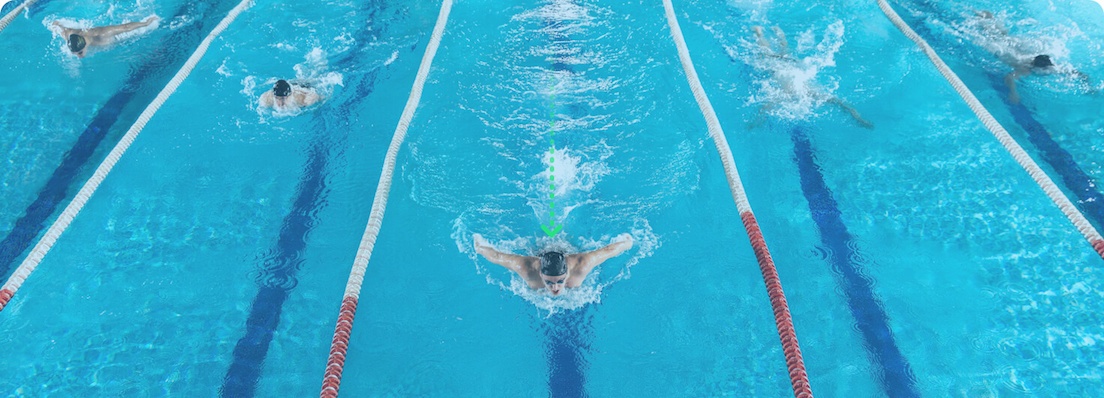
Improving Swimming Speed
One of the first things that comes to mind when thinking about how to swim faster is figuring out how to improve swimming speed. After all, speed is a measure of how fast you’re going.
To calculate your speed, simply divide the distance swam by the time it took to complete that distance (Speed = distance swam/ swim time)
So if, for instance, you want to find your speed per lap, it would be: Speed = length of lap/ lap time. If you want to find your total speed, it would be: speed = total distance/ total time.
Swimming at a faster speed essentially means swimming a given distance in a shorter amount of time. So every aspect of the swim - from the starts and turns, to the underwater and breakouts, to stroke technique and endurance - plays a role in determining speed.
Starts and Transitions
Your starts and push-offs are the 2 points of your swim where your speed is at its peak. So it will be a significant advantage if you are able to maximize the acceleration you generate on these points, retain as much of this momentum through your underwaters, and transfer this speed onto your breakout as you begin stroking.
The key is to consistently put in the effort to properly execute each start, turn, underwater, and breakout in practice. Finish each set strong, even when you’re not training for time. Performing a sloppy turn or gliding through the underwater every now and then may not seem like a big deal, but they add up and turn into bad habits. And once these habits are formed, they are guaranteed to present themselves one way or another in a race.
Stroke Technique
Off your breakouts, your stroke technique and endurance will then take over as the main contributing factors to how fast you swim. After all, stroking makes up the majority of your swim.
Swimming at a faster speed isn't just about moving your arms faster or kicking your legs harder. It’s more about improving your technique and learning to maintain good form as you pick up your pace. Poor form increases drag, decreases swimming efficiency, and raises the chances of incurring injury, which will prevent you from swimming faster.
So, focus on developing good strokes and continuously work on improving your swimming technique. Break down the different components of your swim, isolate each movement or muscle group, and work on them individually by implementing drills in your training.
Once you’ve honed your technique and are able to swim longer distances without compromising your form, that’s when increasing the power of your pulls, or speeding up the tempo of your strokes starts to lead to a faster swim. And when you ramp up the volume and intensity of your workouts, you will be building up your endurance and improving your swimming efficiency, without risking injury.
Identifying Your Starting Point
The first step to increasing your swimming speed is to identify which area you could gain the most improvement from. Maybe you have weak underwaters or slow turns. Or maybe you lose steam before completing your distance or struggle with maintaining the correct technique. Start there.
No detail is too minor, so keep track of everything. This will help you determine how effective your training is, and figure out what is working and what needs to change. Tracking will also help you locate problem areas in your swim that may not be immediately noticeable.
Eventually, work your way through developing your skills in other parts of the swim. Small improvements separately already lead to a faster swim. Imagine how much progress you’ll have when you’re able to integrate them into your overall swim performance.
Not quite sure where to start? Let’s break it down a little further, starting with technique.
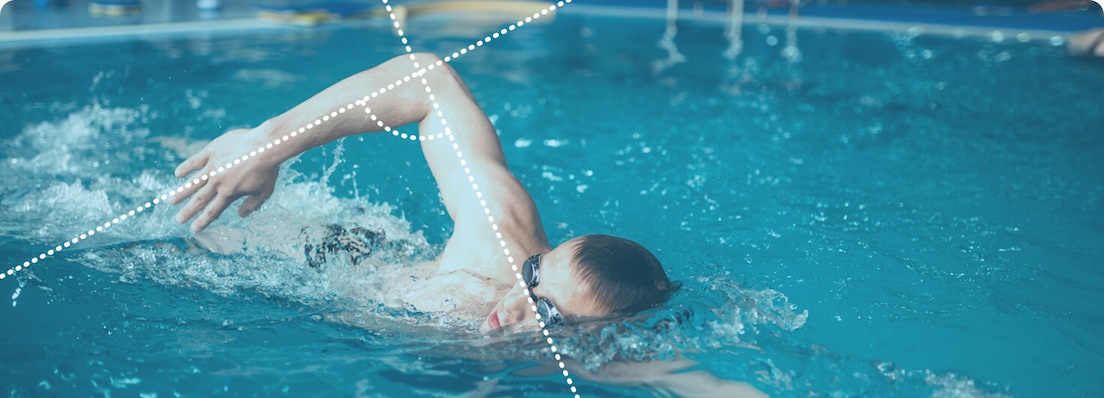
Perfecting Stroke Technique
Perfecting Stroke Technique
The critical role technique plays towards a fast swim is two-fold:
- Minimizes drag
- Improves propulsion
Drag is your biggest enemy
Being in the water means you’re working with plenty of resistance, and resistance equals drag, which is the opposing force against your forward motion in the water. The good news is drag can be kept to a minimum with proper swimming technique.
There are 3 main types of drag in swimming:
-
Pressure or form drag - caused by the swimmer’s body moving through the water
-
Surface or wave drag - caused by water turbulence resulting from the swimmer constantly moving in and out of the water
-
Friction drag - caused by water molecules colliding with the surface texture of the swimmer’s body (i.e. skin, cap, goggles, and suit)
There isn’t much you can do about friction drag other than ensuring you’re not wearing loose articles of clothing in the water. But, pressure and surface drag can be reduced with good swimming technique.
While technique specifics will vary across the different strokes, there are a few common elements that will help reduce drag.
- Streamline off the walls. This position provides the least amount of drag because you’re underwater, moving in a tight line, and taking up less space in the water. The key is to stay in a firm, horizontal line from your fingers to your toes - one hand on top of the other, elbows pushing in towards your head, head down, core tight, legs straight, and toes pointed.
- Maintain good body alignment. No matter what stroke you’re swimming, staying horizontal near the surface of the water will be your most efficient position. Losing your alignment even slightly - pushing your head too far down, lifting it up, kicking too high out of the water, or sinking your lower body will block your forward momentum.
- Master your breathing. Learning how to breathe when swimming is crucial to actually be able to swim for a considerable amount of time and length. But incorrect breathing technique will slow you down. The key is to minimize the time it takes to complete a breath without disrupting body alignment or the flow of your strokes.
- Do not pull with your elbows. For any stroke, dropping your elbows at any part of the pull (including recovery) will increase drag instead of propelling you through the water.
Propulsion is the way forward
Propulsion is the driving force that pushes you forward through the water. In swimming, propulsive force comes from kicks and pulls (and everything that comes with it - i.e. rolls, rotations, undulations, and arm recovery).
The first instinct might be to simply kick harder, or put more force into your pulls. But because you’re in the water and fighting against drag, you can’t just muscle your way to a faster swim. Having good strength and power only contributes to a faster swim if accompanied by correct form and good stroke efficiency.
Good swimming technique for any stroke ensures you’re able to get a firm grip of the water and not slipping through. It also enables you to position your body so that you’re actually pushing the water in the right direction, using the momentum of your pulls and kicks to generate forward speed. This improves your swimming efficiency, allowing you to swim faster without exerting as much energy.
Breathing Technique
When first starting out in swimming, breathing is typically one of the skills you’re actively thinking about and working on. It takes a bit of time and practice to move in a way that allows you to breathe in enough air without gulping down splashes of water. But once you’ve got that down and become more comfortable, breathing then starts to become a natural part of your swim and moves to the back of your mind.
While this is a good sign that you’re improving as a swimmer, continuously working to improve breathing technique will be an added advantage. You will move through the water more seamlessly, preventing unnecessary drag and retaining more speed from the propulsive force of your strokes.
Specific breathing technique will vary across the different strokes, but there are 4 elements to keep in mind that applies to all.
- Head position. Keep a neutral head position when your face is in the water, maintaining good body alignment. This minimizes the movement you need to make for your breath, and reduces the time taken to complete it. For fly, breast, and free, use your strokes as the main driving force of your breath, instead of lifting your head up and down, or craning your neck too far.
- Breathing out. Exhale completely before bringing your face out of the water, even when you’ve held your breath for too long and feel like you’ve run out of air. By doing so, you can immediately start taking in air as soon as your face breaks surface. Taking time to exhale out of the water will only increase your drag and put you off your rhythm.
- Timing. Breathing at the right moment as you move through your strokes is critical for maintaining good body position and retaining speed. You will know your breathing is not in sync with your strokes if it leads to a pause in your pulls or kicks, or if upper or lower body moves out of alignment.
- Breathing pattern. Aside from breaststroke, where you’re required to breathe on every pull, your breathing pattern will depend on the stroke and distance you’re swimming, as well as your personal preference and strategy. So whether you’re breathing every stroke, every 2-3 strokes, or more, the key is to have a consistent pattern for a given event - even in backstroke. This will keep your different movements in sync and help set your rhythm and pace.
The main goals when it comes to mastering your breathing technique are to minimize movement and the time taken to complete each breath, fully integrating the breaths to the strokes to swim more fluidly.
For more tips on improving breathing technique in swimming, check out this post.
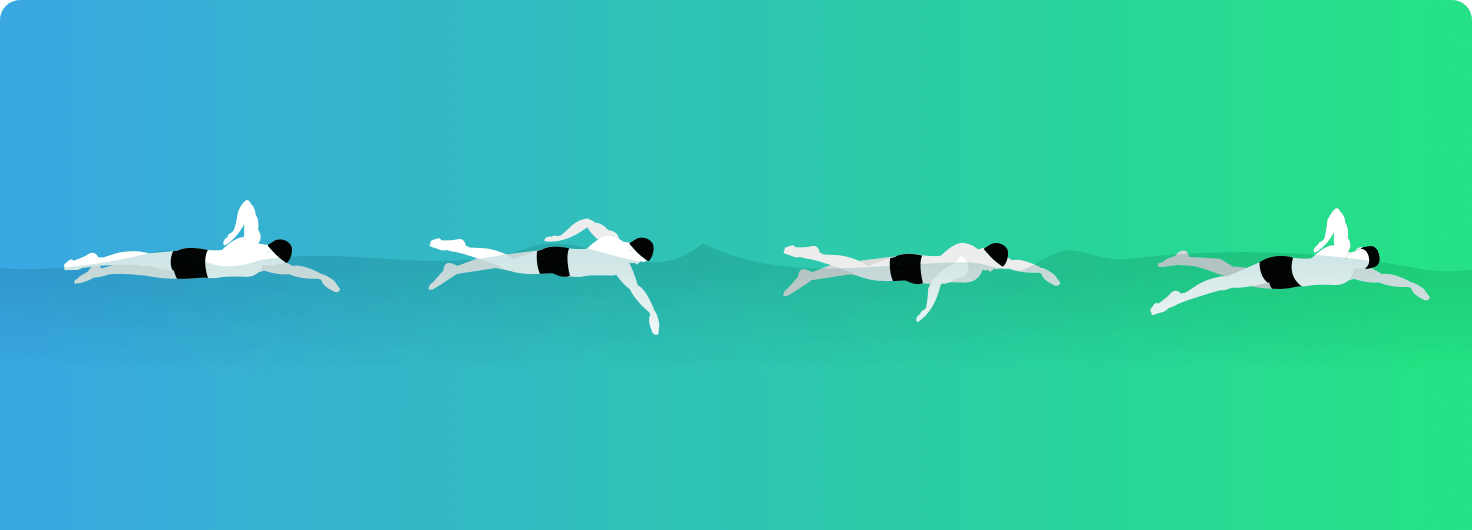
Freestyle
Freestyle is the stroke that most, if not all, swimmers at any level, can swim. It is the only event that ranges from 50m to 1500m in a pool competition, and is the stroke of choice for open water swimmers whose races go from 5km to 25km (and more). This is because freestyle is the most efficient among all the strokes - you can generate a good amount of speed and sustain this for a longer period of time without fatiguing as quickly as you would on the other strokes.
When it comes to improving freestyle, there is no single technique that will work for everyone, especially because of the wide range of distances you can participate in. You may find success in executing a certain kind of pull or following a particular breathing pattern, but this might not be effective for someone else. Or even your personal strategy might differ when you're swimming a sprint versus a distance event.
While you can effectively swim freestyle in different ways, there are a few essentials to swim faster freestyle.
-
Don’t drop your elbows
There have been plenty of debate over the years around whether the s-pull, straight arm, or early vertical forearm is the best freestyle pull. There are a few major differences in the way each pull is executed.
In the S-pull, you do a slight scull at the top before pushing your arms back to the side. In the straight arm pull, your arms go straight back with minimal bend in the elbows. And in early vertical forearm, you pull with your elbows bent at almost a 90 degree angle.
The one thing they have in common is the catch.
The catch happens at the beginning of the pull and is a major factor on how much propulsion you will gain from your stroke. With a good catch, you’re able to get a proper grip of the water, so you’re utilizing the power of your strokes to drive your body forward as you push the water back. Without a good catch, your arms will be slipping through the water, leading to inefficient strokes.
No matter which type of pull you use, the key is to keep your elbows higher than your hands throughout the stroke. Collapsing your elbows won’t provide as much propulsive force, and will increase drag.
-
Test out the different types of pulls at different distances
More than their differences in execution, the pulls also provide their own benefits to your swim.
The S-pull has been found to generate the least amount of propulsion, but is also the least straining on the shoulders. Straight arm allows for more powerful strokes and promotes a faster stroke rate but is harder on the shoulders. Early vertical forearm generates the least amount of drag and provides a good amount of propulsion, but takes longer to complete the stroke.
You may find that straight arm works best for your sprint events and early vertical forearm lets you swim more efficiently in distance events. Or, maybe the s-pull gives you the fastest speed in any distance. It will require a bit of trial and error, but finding your ideal pull will lead to a faster freestyle.
-
Maintain good body position
Your pulls and kicks will give you the propulsive force to power your strokes, but good body alignment is what will help translate this into speed and efficiency.
Stay horizontal, parallel to the bottom of the pool, even as you rotate with your strokes. Keep your head in a neutral position, your core tight, and your toes pointed. Avoid looking up at the wall or down towards your feet at any point, to lessen drag.
Time your breath correctly so your face and recovering arm return to the water at the same time. And, make sure your arms don’t crossover in the recovery. Losing your alignment will not only lead to inefficient pulls, but it will also put you off-balance. Keep your kicks just tight enough so your feet break surface without lifting too high, and deep enough to generate force without sinking your legs and hips.
To read more about how to improve your freestyle, check out this post: How to Swim Faster Freestyle.
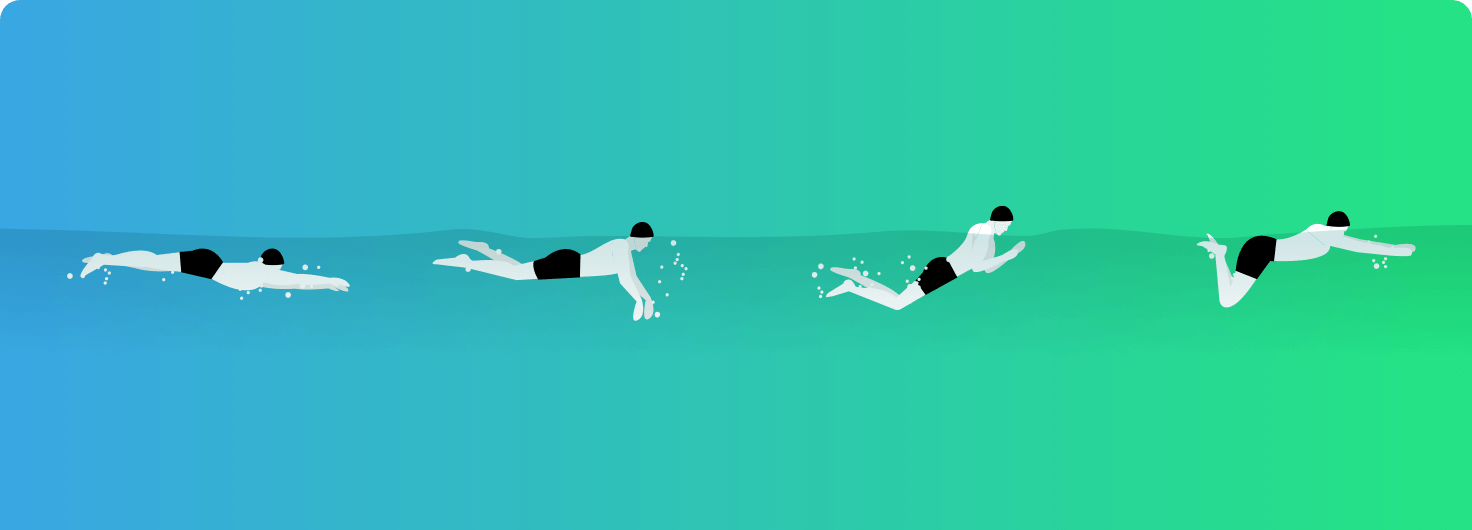
Breaststroke
Out of all the strokes, breaststroke generates the slowest speed. It also takes a considerable amount of coordination and strength to actually perform this stroke well. But, by improving your technique, you will be able to swim a significantly faster breaststroke.
1. Maximize your pullouts
Breaststroke is the only stroke where you can do a pull, breaststroke kick, and dolphin kick underwater, all before you take your first stroke. So it is absolutely essential to optimize your pullouts to retain as much speed and gain a good amount of distance right off the walls.
Capitalize on the momentum from your push-off or starts by maintaining a tight streamline and beginning your pullout before your speed tapers off completely. Get in a powerful dolphin kick and pull, keeping your arms close to your body in the recovery as you execute your breaststroke kick to minimize drag.
You can either execute your dolphin kick before initiating the pulldown or towards the end of it, right before your arms reach the sides of your body. Recent studies suggest that while either way can be effective, timing the kick before the initial pulldown produces greater speed. Test both ways out for yourself to see which works better for you. Whichever timing you decide on, complete the down kick by the time you finish the pulldown to maximize your speed.
Once you’re back in your streamline, time your breakout so you’re not taking your first stroke when you’re still deep under water or too late when you’re already on the surface. A powerful and well-timed first stroke will set you up for a fast length.
2. Develop your kicks
While your arms will help drive you forward, most of the propulsion in breaststroke comes from the kicks. The kicks will also be your greatest source of drag if done with improper form - bringing your knees to your chest, kicking with your knees too wide, or breaking surface with your feet will slow you down.
When doing breaststroke kicks, bring your heels up and back quickly - perform this as quickly as you can as it does not generate any forward speed and can put you off your timing if done too slowly - flex your feet with your toes pointed outwards, and push the water back to bring your legs together. The key to maximizing your kicks is to completely finish each cycle. This is where the most propulsive force is generated. Don’t start the next kick until your legs are back together and you are in your streamline.
Once you have the technique down, work on developing ankle flexibility and leg strength to increase the power of your kicks.
3. Coordinate the timing of your upper and lower body movements
The timing of the pull, breathe, kick and recovery will make the difference between a great breaststroke and a choppy one. Your breath happens during the in-sweep of the arms, keeping your head steady and using the catch to lift up out of the water. Aim to get your heels up as quickly as you can to finish the kick and shoot forward in the recovery.
The key to a fast breaststroke is to build up on the propulsive force from each pull and kick to retain speed in the brief transition period between strokes.
To read more about improving breaststroke technique, check out this post: Why Your Breaststroke Technique is Failing You
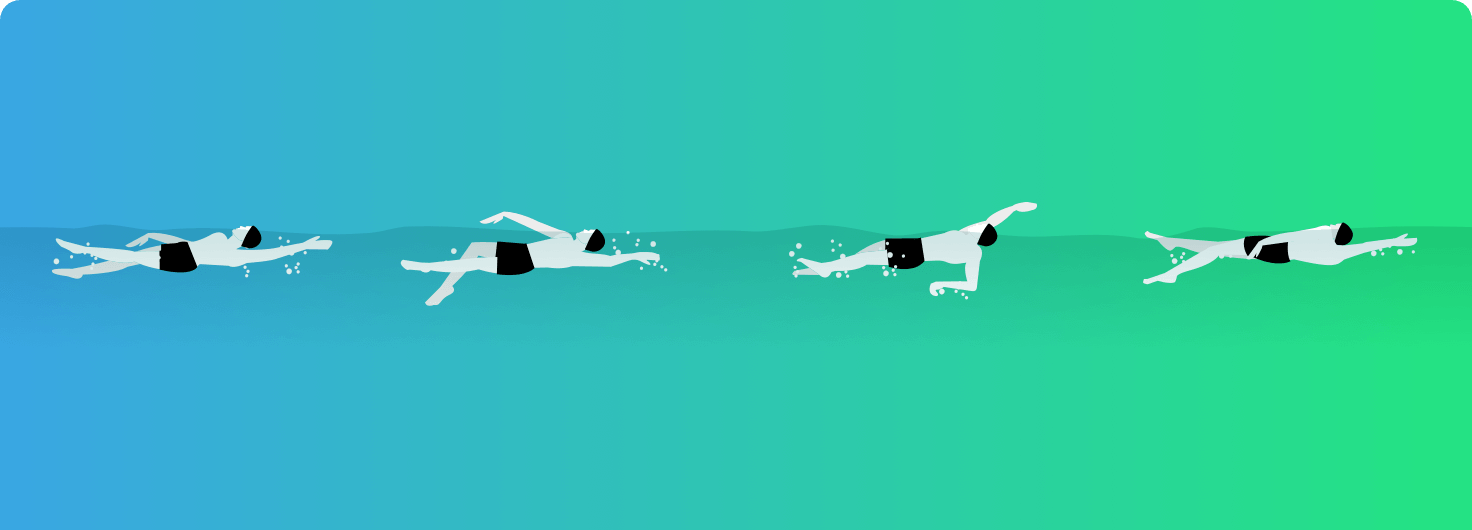
Backstroke
Unlike the other strokes, backstroke is swam purely on the back, which can pose a challenge, especially if you’re still developing your technique. Spatial awareness and feel for the water is slightly different, which makes mastering backstroke technique a little tricky, but not impossible.
There are a few key steps to improve backstroke technique:
- Pull with a shallow catch
The catch is an essential step to swimming backstroke efficiently. A good catch ensures you’re able to maximize the propulsion you generate from your pull by allowing you to get a firm hold of the water and push it back to gain forward speed.
In backstroke, pulling with a deep catch is unnecessary. While it used to be believed that a deeper backstroke catch pushes more water back and provides better propulsive force, more recent studies suggest otherwise. It actually slows down the tempo without producing more distance per stroke.
A shallow catch is ideal, as long as you maintain proper form and time it correctly with your rotation.
To execute a proper catch, bend your elbow when the hand enters the water (slightly outside the shoulder, pinky first and palm facing out), so your forearm and hand are facing the back of the pool, towards your feet. Keep your fingers pointed to your side and your thumb just a few inches below the surface of the water. Once you’re in your shallow catch position, push the water straight back, begin to rotate, and finish your pull with your hand by your hips.
- Perfect the form and timing of your rotation
Proper form and timing of rotation is crucial to get into a good catch position. When you remain completely flat during the hand entry, you will need extra time to properly position your arms for the catch. And, this actually puts excessive strain on your shoulders, increasing your risk of injury.
Rotating on time gives you a good hand entry that immediately sets you up for a good catch.
Good rotation also enables you to recruit your core and back muscles, increasing the propulsion of your strokes. However, while the rotation is essential for an efficient backstroke, you should also be careful not to overdo it. The ideal amount of rotation is around 30 degrees from the surface. Rotating too much will only slow down your stroke rate without producing stronger pulls
During the rotation, hips and shoulders move together, so you’re moving in a tight line from head to toe. Shoulders and arms also rotate together, so your movements stay connected even as you tilt from side to side, cycling through your strokes continuously.
- Focus on your body alignment
Swimming a fast backstroke will require good body position. Ideally, your body will be streamlined and horizontal, just beneath the surface of the water. This means head should be kept still and relaxed, looking straight up at the sky, with the hips and legs kept close to the surface, even as you rotate. This minimizes drag and improves the propulsion of your strokes. Proper body position is also essential for injury prevention.
In addition to improving the efficiency of your strokes, your body alignment will also let you know if you are pulling, kicking, or rotating incorrectly, or if your timing is off.
For instance, if your upper body is moving out of alignment, skewing you to one side, check the form of your pulls. One or both of your arms may be crossing over your midline during the entry. Or it could also be the opposite, where your entry is too wide. Either scenario slows down the initiation of your catch and puts excessive strain on your shoulders.
If your hips and legs are sinking, check in with your kicks. You might be flexing your toes, bending your knees too far back, or kicking too wide. Conversely, if your knees or legs are popping out of the surface of the water, you might be kicking from your knees. Good backstroke kicks start from the hips, with a slight bend in the knees, and finishes the up kick with a slight flick from the feet.
To read more about improving backstroke technique, check out this post: 5 Ways to Optimize Your Backstroke Technique
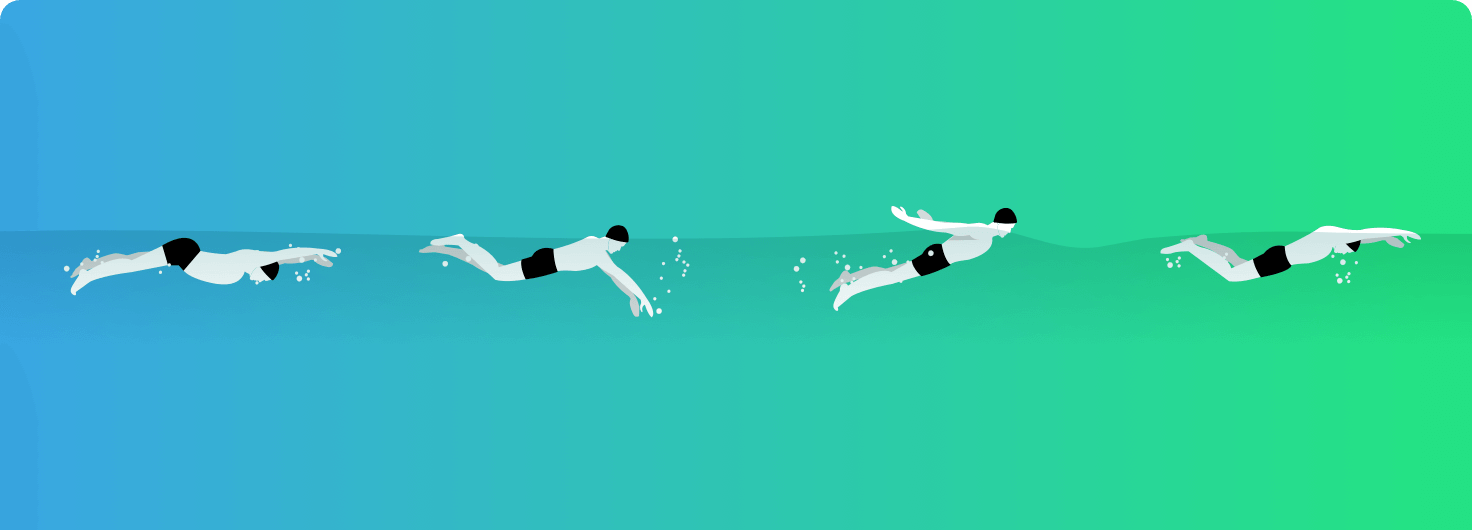
Butterfly
Every swimmer knows how daunting butterfly can be. Sure, plenty of swimmers love swimming fly and are excellent at it. But even more will do anything to avoid racing in butterfly events. And for most, a butterfly set in practice equals a tough set. Just a few laps of swimming butterfly can be exhausting, so it can be difficult to train to improve butterfly speed.
But, there are a few tricks you can focus on to swim butterfly faster:
- Pay special attention to your underwater kicks.
Ensuring each one is powerful on both the up and down kick will give you a good amount of momentum right off the walls. The moment immediately following the push-off and starts are the 2 fastest points in your swim. This is where your speed is at its peak. By maximizing your underwater dolphin kicks, you’re able to retain more of this speed and carry this over to your breakouts, setting you up for a fast length.
The first step to powerful underwater kicks is to keep a tight streamline. While strong dolphin kicks require you to use your core, hips, and legs, your shoulders should be kept still to minimize drag and ensure you're moving in a straight, forward direction.
Actively engaging your lower body for both the up kick and down kick, flexing your feet, and completing your kick in front of your body also maximizes propulsion.
- Be mindful of your body position.
Body position plays an extremely significant role in a faster and more efficient butterfly. Even the slightest change can have an impact on drag, and consequently, your speed.
This means utilizing your hips and core to power your kicks and prevent your lower body from sinking. Ensuring you get in your second dolphin kick each time will also keep your hips and legs from dropping.
Maintaining proper body position also means leading with your chest, not your head, so you’re driving forward with each stroke, instead of pulling into a vertical position. And, this means minimizing your head movement, staying low when you take your breath to keep good alignment.
- Maximize the efficiency of your pulls… and kicks.
Butterfly pulls are not easy, and if done incorrectly, will only serve to slow you down. The main things to remember for the pull is to keep your elbows high for the catch, push your arms all the way back past your hips to finish the pull, and keep your recovery relaxed.
The key though, is managing the timing of your pull and both the first and second dolphin kick. Timing poses one of the biggest challenges in butterfly. A fast fly relies on syncing your movements so the force behind each pull and kick carries its momentum to the next. This applies to every stroke, but more so in fly, where the stroke in itself is challenging enough to perform as is.
Incorrect timing not only prevents you from maximizing the propulsion gained from your strokes, but it also increases drag greatly, which is where the difficulty in swimming fly mostly stems from. Uncoordinated kicks and pulls makes it difficult to complete a full stroke cycle, because you would then need to rely on separate, disconnected movements to bring your entire body forward. But by timing your pull and kicks correctly, you're able to ride the momentum from the previous stroke, making each stroke easier to execute.
To read more about ways to improve the efficiency and speed of your fly, check out this post: How to Swim Faster Butterfly
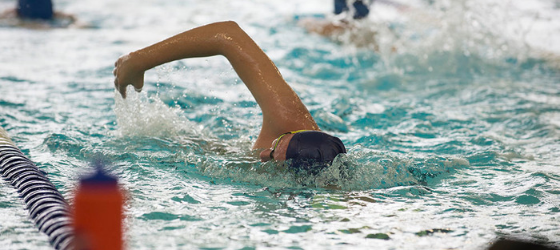
Building Endurance
Swimming endurance is the ability to sustain a faster pace for a longer period of time, without losing proper technique.
Building endurance is somewhat of a positive feedback loop - the more you swim, the more your endurance will improve; the better your endurance, the longer you’re able to swim. With increased endurance, you’ll be able to swim longer without immediately losing your breath or fatiguing your muscles too early on in your workout.
More than managing to swim longer distances, increased stamina means you’re also able to better withstand an increase in the intensity of your training sessions. Higher intensity workouts, if implemented correctly, will help you become a fitter and faster swimmer.
So whether you’re a sprinter or a distance swimmer, incorporating swimming endurance training into your program will be critical to swimming faster.
When it comes to improving your swim endurance, there are 3 main things that will be essential to your success.
- Be patient.
Increasing stamina takes time. It’s important that you don’t rush into it and suddenly increase your training load. In the short term, higher intensity or longer distance workouts will leave you feeling sore and fatigued. But in the long term, your fitness level will improve, as long as the increase in training load happens gradually.
So, while you do need to up the intensity of your training eventually, build up to it slowly, so you don’t risk injury - studies show that likelihood of illness increases by up to 50-70% with intensive training loads.
Going slow and steady also give you time to perfect your form and maintain good technique at a faster speed. This improves your stroke efficiency, so you’re not using up as much energy even as you swim faster. This will increase your capacity to swim longer, both in terms of distance and time.
When your motivation is high, there is a tendency to want to keep pushing yourself and feel like you don’t need to take a break. Take advantage of this momentum but give your body a chance to refuel. Incorporating recovery days into your program will make your training more sustainable long term. This will be key to protecting yourself from overtraining, decreasing your risks of injury and keeping yourself from burning out.
- Stay consistent.
Make it a habit to show up to the pool regularly and keep yourself accountable to your training. Come up with a plan you can realistically commit to long term. Don’t beat yourself up if you miss a session every now and then, but get back into it the next opportunity you have.
Some days will be easier than others to stay motivated and enthusiastic, especially when life gets busy, or you experience an off-day. But, sticking to your training routine will undoubtedly pay off as long as you don’t force yourself past your breaking point - again, recovery days are crucial, so listen to your body.
Consistency here pertains to putting in the hours and effort - getting adequate amounts of sleep regularly, eating right at every meal, and showing up ready to perform. It does not mean doing the same workout every day.
- Switch up your workouts.
Do high intensity interval training. Swim 3000m straight at a comfortable pace. Practice a variety of swimming drills. Do drylands and strength train before you swim. Try cross training. Utilize different muscle groups so your body doesn’t get too comfortable doing the same movements everyday - this will also help prevent injury.
Training at different heart rates by changing the distance, duration, and intensity of your workouts will strengthen your endurance - and keeps training from being monotonous. Come up with a plan so you’re not doing this randomly.
To learn more about building swimming endurance, check out this post: 4 Training Tips to Build Your Swimming Endurance.
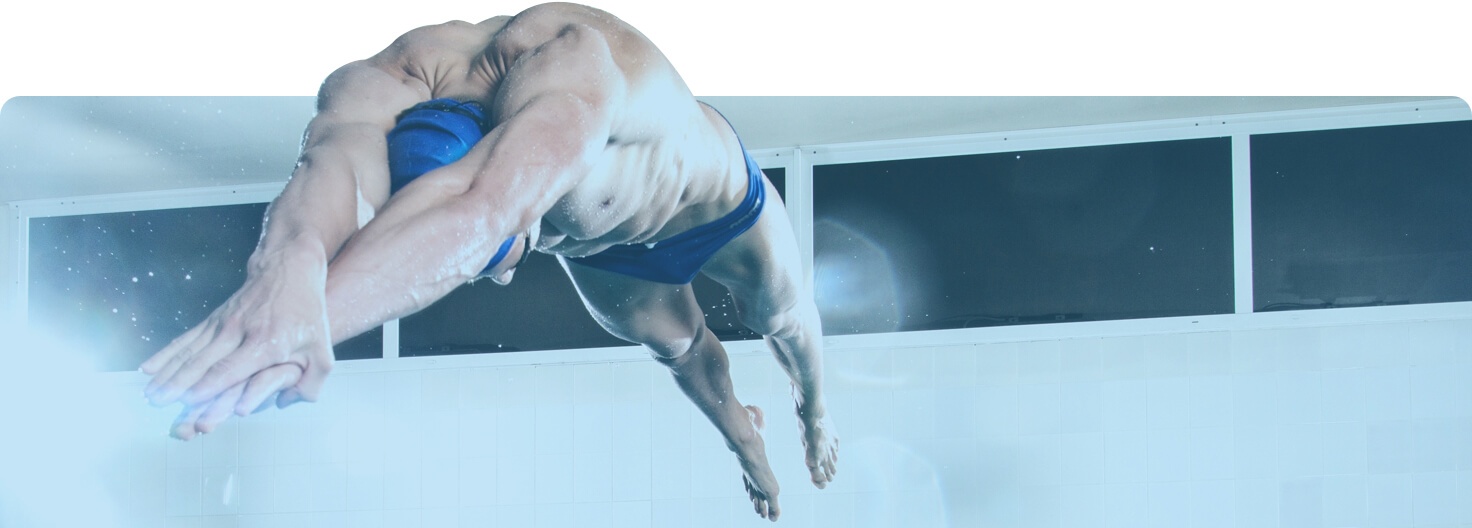
Improving Starts
The moment you jump off the blocks, you’re already setting the tone for the rest of your swim - a fast start sets up for a fast length. There are 2 types of starts for individual events: grab and track start.
- Grab Start. This is where you have both feet side by side at the front of the block, with the hands either in or out of the feet.
- Track Start. This is where you have one foot at the front of the block and the other at the back or on the inclined rear kick plate.
Choose the start that gets you farthest off the blocks the fastest.
There are 3 main parts to any swimming start: the blocks, the flight, and the underwater. Take these into consideration if you’re still deciding on the start type to use, or if you’re looking to improve on the dive type of your choice. Perfecting your technique in each of these components will contribute to a faster swimming start.
- The blocks. This phase of your start begins with your ready stance on the block, to the starting gun going off, and until your toes leave the block.
The ready position on the blocks - having a balanced stance, with good weight distribution - is a big factor in how fast and how powerful your take-off will be. A front weighted start tends to lead to a faster start time, while a rear weighted start tends to provide more forward velocity.
Whether you do a front or rear weighted start, or a track or grab start, keep a slight bend in your knees with your hips higher than your shoulders and your fingers and toes gripping the edge of the block. This position provides better support and added power for your take-off.
If you’re using the kick plate on your track start, the ideal distance of the plate is one that allows your back leg to bend at a 90 degree angle. This position allows for the most effective weight distribution to engage the legs and generate the most propulsion off the blocks.
Engage your core and use your arms to increase the explosiveness of your dive. By recruiting these muscles, you’re able to push back on the blocks to drive your forward motion. This also gets you in a streamline position faster.
- The flight. This is the phase where you are in the air, from the moment your feet leave the blocks until you enter the water.
During this phase, you want to focus on getting into a streamline position as quickly and as efficiently as possible, so you’re able to carry the momentum of your take-off into the water.
A tight streamline in the air is also essential for a clean entry, minimizing the drag created from entering the water, as well as ensuring you don’t land too deep into the water or too high on the surface. Beginning your underwater in either of these depths are inefficient and will lead to added drag.
- The underwater. This phase begins when your fingers enter the water and ends at the breakout.
After the take-off (provided it was executed properly), there is a brief period when your forward velocity is at its peak.
So, a great swimming start isn’t just about getting off the blocks the fastest, or hitting the water the farthest. It’s also, perhaps most importantly, about being able to maximize the propulsion generated from the starts by carrying over that momentum and retaining as much speed into the underwater phase.
The key is to maintain a tight streamline after you enter the water. The less space you take up, the less drag you create. Begin your dolphin kicks or breaststroke pullout before you start slowing down and use the propulsive force of your kicks to build on the speed you gained from the dive.
It is also crucial that you get a feel for where you are in the water. Your depth plays a role in how efficient your time underwater will be, but it also serves as a guide for yourself to know when to break surface. Timing your first stroke correctly ensures you continue to capitalize on the momentum you’ve gained from your starts. Breaking out too early or too late not only makes you lose out on this acceleration, it also creates additional drag that will slow you down.
To learn more about how to improve your swimming start and drills you can implement, check out this post: How to Improve Your Swim Starts

Optimizing Turns
The turns may just take up a small portion of your lap, but they play a significant role in how fast you swim. And in a sport where a fraction of a second can make or break a race, mastering transitions off the walls is critical. The time you shave off from a quicker turn, as well as the momentum you gain, will undoubtedly provide positive results for your swim.
Before diving into the technicalities of a fast flip turn, it’s important to note that while good technique will be key to improving your turns, lazy efforts on the walls will be the biggest barrier to success. It may not be intentional, but there can be a tendency to fall into the temptation of using the walls as a time to sneak in a short rest to catch your breath, or slow down to give your arms and legs a quick break from stroking.
So really, the first step to improving your flip turn is to treat every wall at practice as if you were swimming a race. This means putting in the effort from your warm up, to your main set, and all the way until the end of your workout, even when you’re starting to feel the fatigue set in. This way, executing a fast flip turn will be ingrained into muscle memory, which will only be enhanced when you’re actually in a race.
In terms of improving technique, here are a few essential steps to a faster flip turn.
- Accelerate as you approach the wall.
Keep your head down and don’t glide in. The more speed you carry as you head into the walls, the more momentum you can leverage to turn at a faster rate.
- Count your strokes.
The T line at the bottom of the pool is there for your reference. Know how long it will take you to reach the wall from that point without looking up. This way, you’re able to time your turn correctly without hesitating or slowing down.
- Remove all unnecessary movements as you turn.
This includes taking a breath on your final few strokes and looking up at the wall in your approach. Doing either of these will slow you down. Recruit your arms and core when you’re turning to add power into your flip. But, keep your head, arms, and legs, close to your body to reduce drag- the tighter you are, the faster you roll.
Throw your legs straight up onto the wall and push off once you have your footing. Avoid twisting and turning on your side until after you push-off to reduce the time it takes to complete your turn - pushing off on your side is also not the most efficient push-off position as it creates drag.
- Get into a streamline as quickly as you can.
As you’re completing the turn and pushing off, you want to take up as little space as possible to minimize the drag and maximize the speed generated from the push-off. Streamline is the most efficient position for this.
To learn more about how to improve flip turns, check out this post: Shave Time by Improving Your Flip Turns.
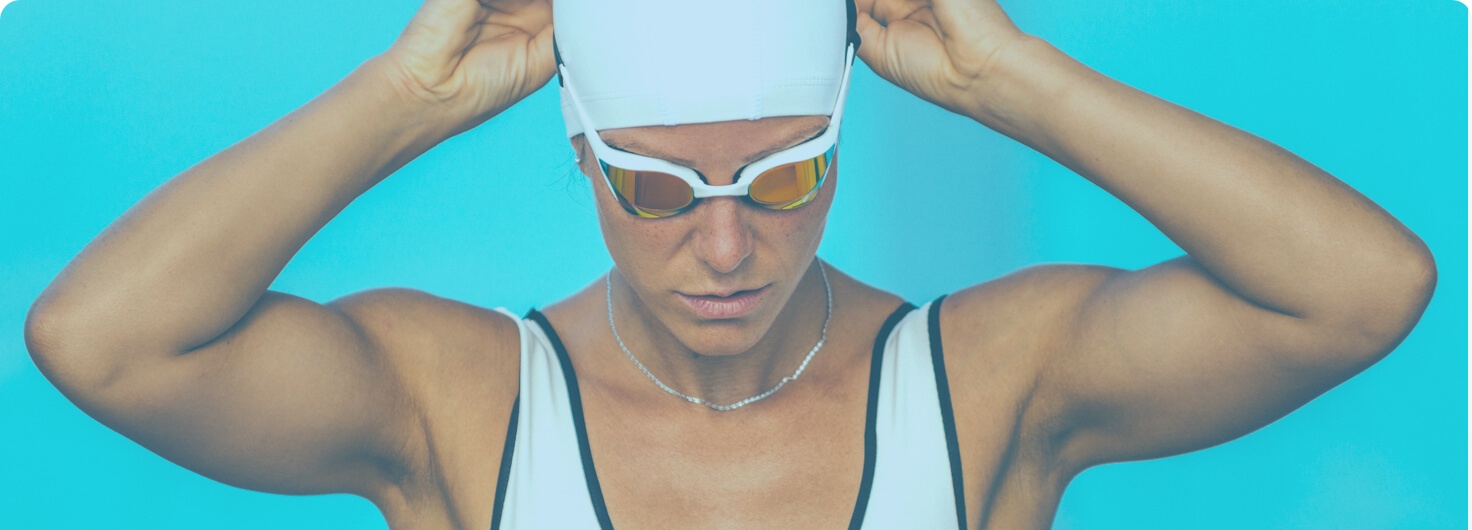
Setting Goals
Improving swimming speed. Perfecting stroke technique. Building endurance. Optimizing starts and turns. There is a lot of work that goes into becoming a faster swimmer. This can be an overwhelming experience, maybe to a point where you wouldn’t know where to begin. Conversely, you might look at this with eagerness, and want to immediately work on improving everything at the same time.
While strengthening these different aspects will contribute to a faster swim, you’re also only in the pool for a limited amount of time. And, if you want peak progress in every component, the best course of action is to come to a training session focused on specific targets, instead of trying to tackle it as a whole.
To figure out where to start, you need to set your swimming goals. Determine what you want to achieve, and break it down to identify your next steps.
In doing this, there are 3 types of goals that will set you up for success.
- Outcome goals
Outcome goals are your ultimate, big-picture goals. These are the major milestones and long term results you aim to achieve throughout the swim season.
Some examples of outcome goals would be:
- Set a meet record at state championships
- Qualify for the national team
- Win a medal at a provincial meet
- Beat a personal best in the 100 fly by the end of the season
Accomplishing outcome goals are typically out of your control, as there are plenty of external factors at play. Someone in your heat might beat you to the wall and set a faster record or edge you out of a podium finish. Or maybe you didn’t get enough sleep the night before your race, throwing you off your game.
Anything can happen come race day. What’s important is that you’ve done what you can leading up to the event and focused on working on the things you can control.
- Performance goals
Performance goals are the benchmark goals you set that will ultimately lead you to your outcome goals. These are the goals that track your progress throughout the season.
Take the outcome goal of beating your 100 fly personal best, for instance. Some examples of performance goals for this could include:
- Consistently complete a 50 fly with 25 strokes or less
- Underwater dolphin kick to the 15m mark off the starts in 5 seconds
- Clock in even splits when training race pace this month, and negative splits in a few weeks
Tracking your improvements this way is an excellent motivator and can give you better confidence in your training process. But, it also informs you if you are still on the right path towards your outcome goals. If you find you’re not making as much progress as you’d expect at a certain point in time, checking in on your performance goals regularly gives you the opportunity to re-assess and adjust your training with enough time before the race.
- Process goals
Process goals are the specific, day-to-day actionable steps you need to implement that build up to your performance and outcome goals.
Some examples of process goals could be:
- Attend every practice, including both the morning and afternoon sessions
- Approach each set with the proper mindset
- Put in the effort from start to finish, including turns and underwaters.
- Get adequate amounts of sleep each night
Accomplishing these targets is something you have full control over, so having process goals keeps you focused and accountable to your training. The best way to reach your outcome goals for the season is to consistently hit your process goals.
The key to setting goals at each of these levels is to keep it SMART.
Specific. ‘Swim faster’ shouldn’t be your only goal. Define it.
Measurable. Have a criteria for success so you can track your progress.
Attainable. Is your goal something you can reasonably accomplish given where you are today?
Realistic. Commitment is absolutely critical to achieving any goal. Are you willing to commit to the goals you’ve set?
Time-bound. Have an end date. Deadlines drive action.
To read more about setting swimming goals effectively, check out this post: 5 Ways to Set Your Swimming Goals for the 2019 Seasons
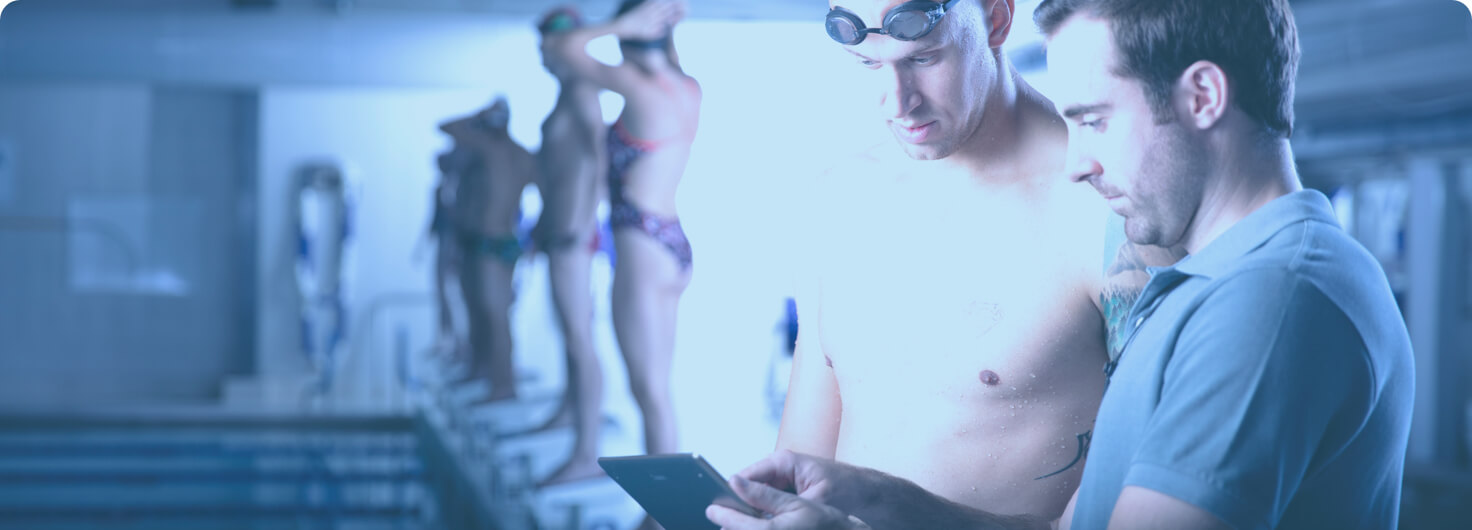
Create a Training Plan
With your goals on hand, the next step is to start building an effective swimming training plan.
While it’s true that your swim can improve by consistently showing up to the pool and doing your laps, swimming random sets do not guarantee faster swimming results. Your time at the pool is limited, so smarter training will enable you to use your time more efficiently and really make the most out of each session. This starts with having a training plan.
When it comes to developing a swim training plan, there are a couple of things to keep into consideration.
Periodization
Periodization is the process of structuring a training plan so that athletes are in a condition to achieve peak performance at their major competitions. A periodized swim training plan divides training into progressive cycles and phases, to develop specific skills and capabilities during a specific time period. This way, you’re giving your body just enough time to strengthen specific skill sets before focusing on to the next, without being too monotonous in your workouts.
Periodized plans optimize training in both the long term and short term, and are divided into 3 cycles: macrocycles, mesocycles, and microcycles.
Macrocycles
Macrocycles are the longest among the 3, and are more focused on the long term. These are typically seasonal or yearly plans where you will undergo different types and phases of training.
When planning your macrocycles, note the major competitions of the year where you want to be in peak condition. Your macrocycle will be the time from the start of your training period to the final day of that competition, the next macrocycle will then begin, ending at the next major competition, and so forth.
Mesocycles
Mesocycles are the training blocks within a macrocycle which have a more specific objective at the end of each cycle. There are typically 3-4 mesocycles within 1 macrocycle, each one ranging from 6-8 weeks, to give the body enough time to adapt to physical changes and actually translate into performance gains. But, this will vary depending on how long your macrocycle is, and what your specific goals are for that macrocycle.
Microcycles
Microcycles are typically a week in length, each having a more targeted focus within a mesocycle. This is where you have your main sets varying volume and intensity, focusing on improving endurance, sprints, strength, lactate threshold, or lactate production, and will dictate your daily workouts. Microcycles are highly variable across different teams and swimmers because they are dependent on your personal goals, current capabilities, and the time and resources available to you.
Injury Prevention
A major component of being in peak athletic condition is being free from any injuries. Even minor injuries can be a major setback, so it’s important to be mindful of the stress your body undergoes on a regular basis.
When you’re mapping out your training plan, you will be playing around with different volumes and intensities to get your body into the right training zones for the specific objectives of your cycle. The key is to ensure the changes in training load happen gradually from day to day, from phase to phase, and from cycle to cycle. Sudden and drastic changes in training load have been shown to increase risks of injury and illness.
So, as you develop your plan for the year or the season, make sure there’s enough variety in your training to avoid plateauing, but leave sufficient amount of time for your body to catch up. And while your training plan will be your framework for the season, this is not a fixed plan. You will need to constantly evaluate your progress to determine if there are tweaks you need to make along the way. Fine tuning your training to your specific context will be key to swimming faster.
To read more about creating a training plan, check out this post: How to Build a Winning Swim Training Plan


